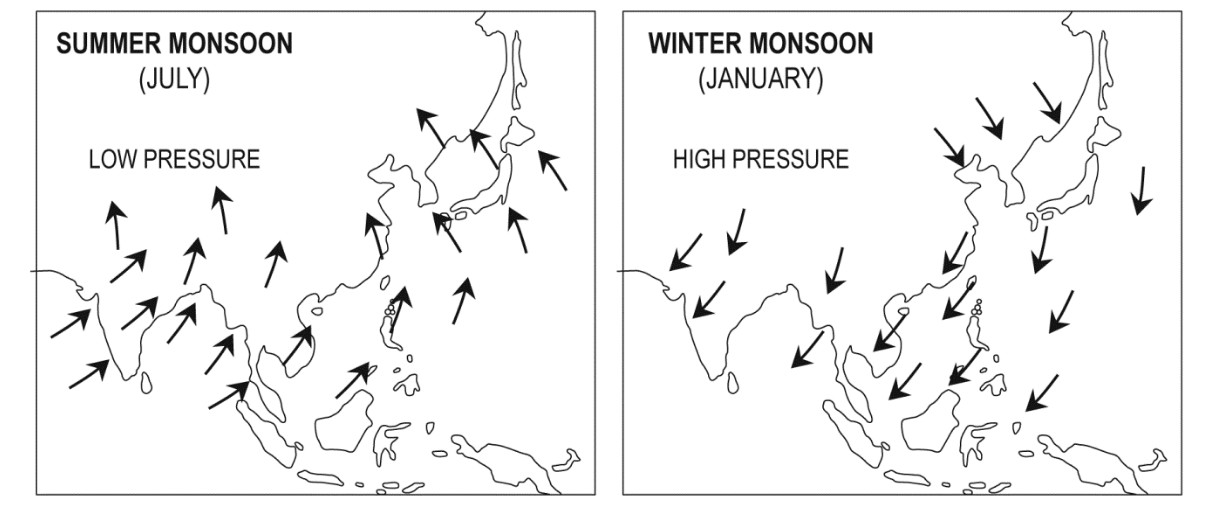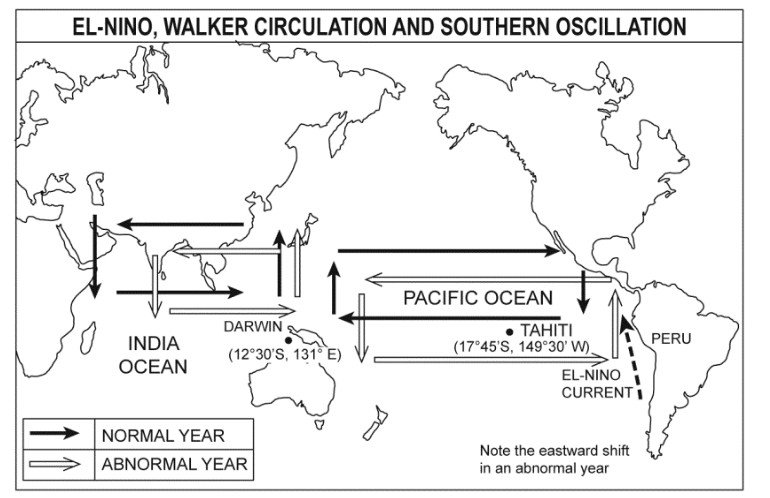Why in the News?
According to the India Meteorological Department (IMD), the southwest monsoon began its earliest withdrawal in a decade on September 14 from western Rajasthan, three days before the usual date of September 17.

What is Monsoon?
- Overview: A seasonal reversal of winds, southwest winds (wet) in summer and northeast winds (dry) in winter.
- Onset Date: Officially begins June 1 over Kerala, advances northwards, covering entire India by mid-July.
- Importance: Accounts for ~75% of India’s annual rainfall, critical for Kharif crops, water storage, and ecosystems.
Mechanism of Monsoon Onset:
- Differential Heating: Indian landmass heats faster than the Indian Ocean, creating low pressure over NW India that pulls in moist winds.
- Mascarene Highs:
- Located near Mascarene Islands (east of Madagascar).
- Strengthen during May–June winter in Southern Hemisphere.
- Push strong cross-equatorial winds from the SE Indian Ocean towards India.
- Cross-Equatorial Flow:
- Southeast trades from Mascarene High cross the equator.
- Deflected by Coriolis, they become southwest monsoon winds, feeding both Arabian Sea branch and Bay of Bengal branch.
- ITCZ (Intertropical Convergence Zone) Shift: Moves northwards over Ganga plains, anchoring the monsoon trough.
- Tibetan Plateau Heating: Acts as an elevated heat source, deepening low pressure.
- Jet Stream Influence:
- Subtropical Westerly Jet (STWJ) shifts north of Himalayas, allowing the monsoon trough.
- Tropical Easterly Jet (TEJ) develops, enhancing moisture flow.
- Local Triggers: Orographic uplift along Western Ghats, NE Hills, and Indo-Gangetic plains causes heavy rains.
What is Retreat/Withdrawal of Monsoon?
- Earliest Withdrawal (2025): Began Sept 14 from western Rajasthan — earliest in a decade (normal = Sept 17).
- Withdrawal Process: Gradual, completes by mid-October.
- IMD Withdrawal Criteria:
-
- Development of anti-cyclonic circulation at lower troposphere.
- No rainfall for 5 consecutive days over the region.
- Prevalence of dry weather conditions.
- Seasonal Marker: IMD fixes Sept 30 as the official end of SW monsoon.
- Agricultural Role: Retreat moisture crucial for Rabi crop sowing.
Influencing Factors for Monsoon Retreat:
- Seasonal Cooling: Reduced solar heating over land in September weakens low pressure.
- Pressure Gradient Reversal: High pressure redevelops over NW India, collapsing SW winds.
- ITCZ Shift: Moves back southwards towards the equator, reversing wind patterns.
- Jet Stream Role: TEJ weakens, westerlies return, pushing out moist winds.
- Topography & Seas: Coastal and mountainous regions (e.g., SE peninsula, Bay of Bengal) may still receive residual/post-monsoon showers.
- Mascarene Highs: As SH winter ends, Mascarene highs weaken, cross-equatorial inflow diminishes, aiding withdrawal.
Climatic Phenomena affecting the Indian Monsoon:
1. ENSO (El Niño–Southern Oscillation):
2. Indian Ocean Dipole (IOD):
3. ENSO–IOD Interaction:
The Big Picture:
|
| [UPSC 2012] Consider the following statements:
1. The duration of the monsoon decreases from southern India to northern India. 2. The amount of annual rainfall in the northern plains of India decreases from east to west. Which of the statements given above is/are correct? Options: (a) 1 Only (b) 2 Only (c) Both 1 and 2* (d) Neither 1 nor 2
[UPSC 2017] With reference to ‘Indian Ocean Dipole (IOD)’ sometimes mentioned in the news while forecasting Indian monsoon, which of the following statements is/are correct? 1. The IOD phenomenon is characterized by a difference in sea surface temperature between tropical Western Indian Ocean and tropical Eastern Pacific Ocean. 2. An IOD phenomenon can influence an El Nino’s impact on the monsoon. Select the correct answer using the code given below: (a) 1 only (b) 2 only * (c) Both 1 and 2 (d) Neither 1 nor 2 |
Get an IAS/IPS ranker as your 1: 1 personal mentor for UPSC 2024


